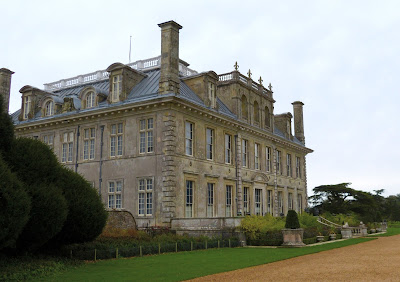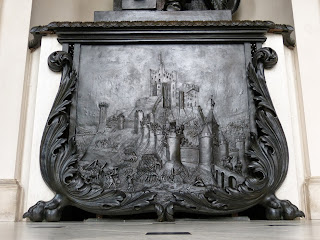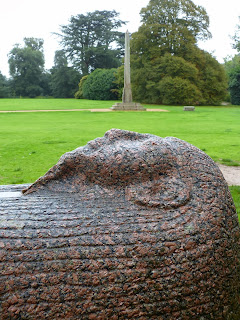 |
| Kingston Lacy from the garden (2013) |
The Kingston Lacy estate is situated near Wimborne in Dorset.
 |
| Kingston Lacy (2016) |
Sir John Bankes, MP and Lord Chief Justice, bought the Isle of Purbeck, Corfe Castle and the Kingston Lacy estate in 1635-6. During the Civil War, Sir John’s wife defended the castle for the King, but was defeated in 1646, and Corfe Castle was destroyed by the Parliamentarians.
 |
| Bronze relief of the siege of Corfe Castle, in the house at Kingston Lacy (2013) |
In 1663, Sir John’s son, Sir Ralph Bankes, commissioned the architect Roger Pratt to design a new family seat on the Kingston Lacy estate. The building and furnishing of Kingston House put Sir Ralph seriously into debt and his son was obliged to lease it to the 1st Duke of Ormonde to save money. In 1693, the family was able to return to Kingston Hall and it remained the residence of the Bankes family until 1981 when it was given to the National Trust, as part of a huge bequest which included Corfe Castle and much of the surrounding land.
Georgian connection
Kingston Lacy was owned by the Bankes family throughout the Georgian and Regency periods.
Henry Bankes (1698-1776) inherited from his brother John in 1772 and, although already in his seventies, he reorganised the estate with great determination.
Henry Bankes the Younger (1757-1834) was a Tory MP and a trustee of the British Museum. He was married to Frances Woodley, a renowned beauty. His alterations to Kingston House included the creation of a ballroom.
William John Bankes (1786-1855) was a friend of Lord Byron and travelled extensively. He was an early Egyptologist and his acquisitions included the Philae obelisk. His modifications to Kingston House included the creation of the Spanish room to house his collection of Spanish paintings and a grand marble staircase. He was forced into exile in 1841 due to accusations of homosexuality.
 |
| The sarcophagus and the Philae obelisk (2013) |
George Bankes (1787-1856) managed the family estates in his brother William’s absence. His widowed sister, Anne, Lady Falmouth, lived at Kingston Lacy from 1841 whilst he lived on the family’s Corfe estate. George was married to Georgina Charlotte Nugent, reputedly the illegitimate daughter of Ernest, Duke of Cumberland, by Lady Nugent. He was Tory MP for Cambridge and opposed Catholic emancipation and the reform bill. He was mayor of Corfe three times and wrote The Story of Corfe Castle and of Many who have Lived There (1853).
What is there to see today?
Kingston Lacy is owned by the National Trust. Particular things to look out for are:
• The original keys of Corfe Castle on display in the library.
 |
| The keys of Corfe Castle (2013) |
• The portrait of Frances Woodley by George Romney in the drawing room (what was the ballroom in her day).
 |
| The drawing room, Kingston Lacy (2013) - the portrait of Frances Woodley is on the right |
• The portrait of Charlotte Dee, Lady Nugent, the Duke of Cumberland’s mistress and mother to George Bankes’ wife Georgina, painted by Sir Thomas Lawrence, on display in the drawing room.
• The marble staircase.
• The bronze sculptures of Sir John and Lady Bankes and Charles I sitting above a relief of the siege of Corfe Castle on the half-landing up the marble staircase.
 |
| Sculpture of Lady Bankes (2013) |
• William Bankes’s Egyptian collection in the billiards room.
 |
| Part of William Bankes's Egyptian collection (2013) |
• The Philae obelisk on the south lawn. Be sure to read the metal plates around the bottom – they are quite amusing! You can read more about the Philae obelisk here.
• The sarcophagus on the south lawn.
 |
| The sarcophagus and the Philae obelisk (2013) |
Rachel Knowles writes clean/Christian Regency era romance and historical non-fiction. She has been sharing her research on this blog since 2011. Rachel lives in the beautiful Georgian seaside town of Weymouth, Dorset, on the south coast of England, with her husband, Andrew.
Find out more about Rachel's books and sign up for her newsletter here.If you have enjoyed this blog and want to encourage me and help me to keep making my research freely available, please buy me a virtual cup of coffee by clicking the button below.
Sources used include:
Bankes, George, The Story of Corfe Castle, and of Many who Have Lived There (1853)
The National Trust, Corfe Castle (guidebook) (1985)
The National Trust, Kingston Lacy (guidebook) (1994)
Photographs by © RegencyHistory


Nice overview of the estate and history~ love this stuff!
ReplyDeleteThanks. I find it helpful to highlight the Georgian connection with places I visit and thought others might too. :)
Delete